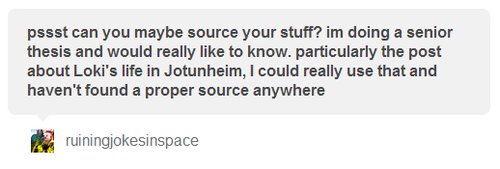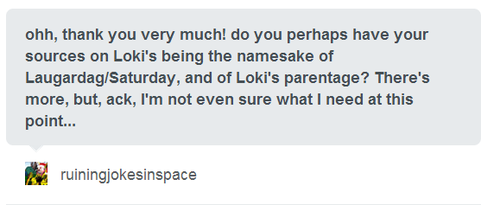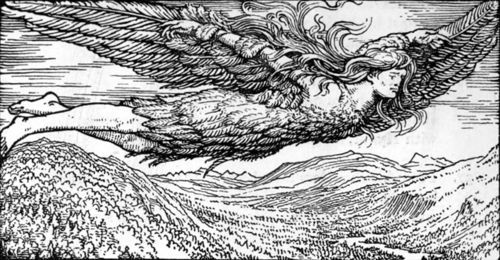#jotunheimr

Of course! I hope this is a good way to do it - I’m not very tumblr-savvy…

I’ve been meaning to start sourcing everything, but it will probably take a bit of time, since a lot of the information is just kind of my accumulated knowledge (I’ll do my best though!). About Loki’s life in Jotunheim specifically, let me see… I know the first time I read about it was in The Norse Myths by Helena Yvette Grimes, but that book is not really an academic one, and it’s very inaccurate in some parts. This website’s (http://shadowlight.gydja.com/loki.html) info on the subject is accurate and well-written, but this website is not academic either. Myths of the Norsemen by H.A. Guerber, an academic text, touches on Glut, Eisa, and Einmyria in chapter 22 (http://free.sbooks.net/H_A_Guerber/Myths_of_the_Norsemen/kindle.html), but not in exceptional detail. From a cursory sweep of my sources that I expected to have the right information, that is what I’ve found. Let me know if you want me to find more sources. I know there ARE more, but I’d have to reread a lot of material to locate the others. I definitely don’t mind doing this, since I should have been citing my sources from the beginning. Also, it’s always good to refresh knowledge. So just let me know if you’d like me to dig a little deeper. Thanks for bearing with me!

I’m so sorry for not responding sooner! The Laugardag/Saturday is also primarily from H.A. Guerber’s Myths of the Norsemen. Loki’s parentage is a bit trickier, because nearly every piece about Loki will mention Loki’s parentage, but they all say different things. It’s because no one is quite in agreement on Loki’s true origins. For that reason, what I’ve posted here might not even be the most accurate answer.
The H.A. Guerber text cites the three different possibilities of Loki’s parentage, in chapter 22 like the information on Eisa, Einmyria, and Glut. [1]One possibility is that Loki was among the family of original gods with Odin and Hoenir, since the three make up a common triad. There is also the possibility that Loki was:
“[2]the son of the great giant Fornjotnr (Ymir), his brothers being Kari (air) and Hler (water), and his sister Ran, the terrible goddess of the sea. Other mythologists, however, make him [3]the son of the giant Farbauti, who has been identified with Bergelmir, the sole survivor of the deluge, and of Laufeia (leafy isle) or Nal (vessel), his mother” (Guerber).
I’m sorry to keep suggesting the Guerber text, but many other mainstream texts are painfully inaccurate (with respect to older sources and artefacts) and suffer from some form of factual distortion. This is one of the few that doesn’t, so it’s a good source of information.
This (http://shadowlight.gydja.com/loki.html) well-informed/written but non-academic site that I’ve suggested before details Loki’s descent from Farbauti and Laufey.
I’m fairly certain that Rudolf Simek’s Dictionary of Norse Mythology provides a good explanation on Loki’s parentage, but I don’t know on which page it is.
Otherwise, you can always use more original sources, like Snorri’s Prose Edda Gylfaginning, in which it is explicitly stated that Farbauti and Laufey are Loki’s father and mother. It also describes their escape from the flood. The Prose Edda Skaldskaparmal calls Loki “son of Farbauti and Laufey”, “Farbauti’s son”, and “Farbauti’s sly son”.
I owe you a lot more sources than this, but I study this field for leisure only, so I haven’t kept very good record of my sources. I am currently going through all texts/research papers/articles/websites I have saved up, so that I can properly document everything on here (It may take a while though). Until then, I hope this will do!
Thor awoke one morning to find that the hammer Mjolnir, given to him by Loki, had been stolen. Seeking aid, Thor appealed first to Loki, who was both his dearest friend and the god most capable of solving problems. Loki suspected the thief had been a Jotunn, so he volunteered to fly through Jotunheimr, to seek out Thor’s hammer. Thor supported the idea, so he accompanied Loki to Freya to ask to borrow her falcon cloak. With Freya’s approval, Loki donned the cloak and set off to Jotunheimr to find Thor’s hammer.

As he flew over Jotunheimr, Loki noticed Trymr, a Jotunn prince whom he suspected. Trymr asked Loki how the gods and alfs were faring, and why Loki was in Jotunheimr. Loki informed Trymr that things were not well for the gods, and proceeded to ask Trymr if he had taken Thor’s hammer. The Jotunn admitted to the theft, but he had buried Thor’s hammer many miles beneath the ground, so no one could retrieve it but Trymr himself. Trymr would return Thor’s hammer if the goddess Freya came to his kingdom to be his bride.
Loki returned to Asgard with the news, and on hearing it, Freya became so furious that her necklace Brisingamen broke. She did not want to marry Trymr, and the other gods would not want to lose Freya either. A meeting was held among the gods to decide how to proceed. They needed Thor’s hammer for the power it granted them over Asgard’s enemies, but they did not want to give up Freya. Then Heimdallr suggested that since the hammer was Thor’s property, Thor should be the one to wed Trymr to retrieve it. All gods but Thor agreed with the idea.
The gods dressed Thor in a wedding dress, strapping two round stones to his chest to resemble breasts. They then covered his face with a wedding veil. Loki volunteered to accompany Thor as his maid, in both solidarity and in case his skills were needed to resolve more trouble. In addition, Thor’s deep voice was certain to give him away, so he needed someone to speak for him. The details of Loki’s disguise were not mentioned in detail, but I think that since Loki is a shape-shifter capable of changing into anything, Loki had no need for a crude disguise like Thor’s. Instead of trying to look like a woman, I imagine he simply transformed himself into a woman.

Thor and Loki, dressed for the wedding, journeyed to Jotunheimr, proclaiming themselves to be Freya and her maid. Trymr was very excited that his bride had indeed come, and the celebration began immediately. But Thor’s appetite was anything but ladylike, and he consumed an entire ox himself. Trymr wondered at why Freya would have such an appetite, and Loki quickly answered that Freya had been so excited for the wedding that she had not eaten for the past eight days. Trymr was satisfied with the explanation, and lifted Thor’s veil to see his eyes. Thor’s eyes were bloodshot and fierce, and Trymr, startled, wondered why Freya had such eyes. Loki explained that Freya had been so excited for the wedding that she had not slept for the past eight days either.
As the ceremony progressed, the hammer was finally brought out to be presented to Freya (who was really Thor) as a bridal gift. It was at this time that Trymr’s sister approached Thor and demanded he give her a present to win her favour. Thor smiled as the hammer was set in his lap, having his weapon returned, and he proceeded to slay Trymr and his sister, and probably also the other wedding guests. With the hammer returned and the Jotunn thief dealt a harsh justice, Thor and Loki returned to Asgard.
A Jotunn called Rasvalg once caused a great deal of trouble for Midgard. In the form of an eagle, he fanned great gusts of wind across the land, causing plants, animals, and men to die. Loki and Thor resolved to put an end to this mischief, and set out for Jotunnheimr in Thor’s goat-drawn chariot. While passing through Midgard, they stopped to rest one night in the home of a poor farmer with a wife and two children. The family did not have enough food to properly accommodate their guests, so Thor slaughtered his two goats to feed the group. Thor asked that the bones be laid on the skins when the meal was finished, and that no one break the bones.
Sensing an opportunity for mischief, Loki suggested to the farmer’s son, Tjalfe, that he should break open the bone to eat the marrow inside, reasoning that it was the best part, and contained magical properties. Tjalfe agreed with Loki’s logic, and did as was suggested. In the morning, Thor resurrected his two goats from their bones and skin, using his hammer. But one of the goats was lame, because of Tjalfe’s actions.

Thor was furious at the insubordination, but the father eventually managed to quell Thor’s temper by offering his two children, Tjalfe and Roskva, as servants. They would accompany Thor and Loki to Jotunnheimr, and the group would return after their mission to retrieve Thor’s two goats.
They set off once more, and that night they found a cave that contained five different passages. Startled by roaring sounds outside, they hid themselves in the back of the smallest passage and stayed there for the night. When they awoke and emerged from the cave, they found that the sound had been the snoring of a giant Jotunn, and the passage of what they thought was a cave was actually the thumb of the giant’s glove. The giant introduced himself as Skrymir, and offered to accompany the group. He took it upon himself to carry their provisions, but the giant’s strides were so long that the group could not stop to rest at all, and they were not able to eat all that day.
When Skrymir finally stopped to sleep for the night, the group was famished. They attempted to open the bag to their provisions, but they could not untie the knots with which the giant had sealed it. Even Thor’s immense strength was no match. Frustrated, Thor attempted to wake Skrymir, but the task seemed impossible. Thor threw his hammer three times at the giant’s head, each time with more force than the last. But Skrymir only mumbled that a leaf or an acorn must have fallen on him, and he promptly returned to sleeping each time.

They set out again the next day, and Skrymir announced that he was going on ahead, and they quickly lost sight of him. Eventually, Thor, Loki, and Tjalfe arrived at the castle of the Jotunn Utgarda-Loki (no relation to Loki). The group proceeded to attempt a series of contests, in order to prove themselves worthy of staying at the castle. Loki, hungry from losing his provisions to Skrymir, offered that he could eat more than any Jotunn there, and thus, an eating contest was begun. Loki and his opponent Logi began eating at opposite ends of a trough, and they both reached the exact middle at the same time. However, Loki had only eaten the food, while Logi had eaten the food, the bones, the dishes, and the trough, so Loki lost.
Tjalfe fancied himself to be a swift runner, so he competed against one called Hugi in a footrace. Although Tjalfe was indeed faster than most, he too was defeated by his opponent. Thor then asserted that he could drain a drinking horn, and so a horn was provided for him. Thor drank until he was about to burst, but could only lower the level by a small amount. It was then suggested that Thor lift Utgarda-Loki’s cat, but in this task Thor could only lift one paw. Finally, a feeble, elderly woman named Elli was called out to wrestle with Thor, and in this task too Thor was defeated.

Utgarda-Loki escorted the three humbled guests out of his castle, and once they were outside, he revealed to them that they had been tricked. Fearing the strength of his visitors, Utgarda-Loki had disguised himself as Skrymir, and he had tied up their food so they would be weak with hunger when they arrived at his castle. When Thor had attempted to strike Skrymir’s skull with his hammer, the hammer blows instead had fallen on a nearby mountain, and the force of the blows had created three deep valleys. If any one of the blows had struck Utgarda-Loki, he would have died.
Loki’s eating contest had been against fire, which consumes everything in its path, so it was incredible that Loki was able to perform as well as he had against the flame. Tjalfe’s footrace had been against thought, which works quicker than anyone can run. Thor’s drinking horn had been attached to the sea itself, and Thor had actually managed to lower the level of Midgard’s oceans with the amount he drank. The cat Thor was tasked with lifting was in fact Jormungandr, the Midgard serpent so large it encircled the world, so lifting its paw was an incredible feat of strength. Finally, the old woman had been old age itself, and old age eventually brings everyone, even gods, to their knees. That Thor had lasted as long as he did was better than anyone could have achieved.
Utgarda-Loki apologised for the trickery, but confessed that he was right to do so, because the strength of the group was terrifying, and he could never have beaten them through honest means. Thor raised his hammer, frustrated that he had been made to look a fool, but before he could attack, both Utgarda-Loki and his castle had disappeared. Tjalfe and Roskva returned with Loki and Thor, and served Thor from then on.
In early Norse mythology, before the Aesir became a more prominent force, Loki was more closely related to fire and hearth, and to weather. His name was also very similar in pronunciation to the Jotunn fire spirit Loge, further casting him in that role. Presumably before he had met Odin, Loki lived in Jotunheimr with a wife called Glut (Glow) and their two daughters Eisa (Ember) and Einmyria (Ashes).
When waves of heat could be observed as rising from the ground, it was said that Loki was sowing his oats. When moisture evaporated, it was attributed to Loki collecting the moisture to make a drink. Among the Nordic people, when flames crackled on the hearth, it was said that Loki was beating his children. When rain fell despite the sun being out, it was said that Glut was weeping.
As stories of the gods of Asgard began to gain popularity, Loki’s role soon progressed to one of the Aesir. Loki left his old life behind and moved to Asgard, where he was at some point associated with a new wife, the Aesir Sigyn.
